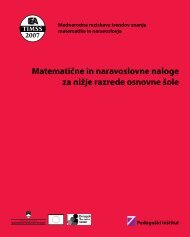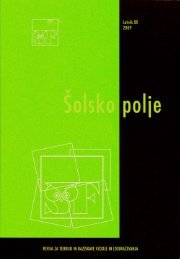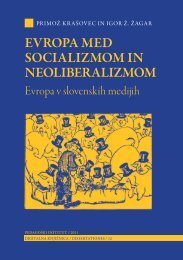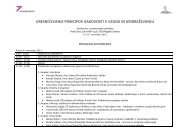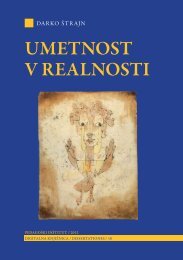Šolsko polje, letnik XX, številka 5-6, 2009: Vloga ... - Pedagoški inštitut
Šolsko polje, letnik XX, številka 5-6, 2009: Vloga ... - Pedagoški inštitut
Šolsko polje, letnik XX, številka 5-6, 2009: Vloga ... - Pedagoški inštitut
Create successful ePaper yourself
Turn your PDF publications into a flip-book with our unique Google optimized e-Paper software.
JOURNALISTIC (RE)PRODUCTION OF HISTORY: TELEVIZED COVERAGE OF RADOVAN ...918. Zoran Pavlović declared: European Union plays politics of negotiations.They have to reward us for this arrest – for example, they have toformally cancel visas for Serbian citizens, they have to accept Serbiainto the EU candidature, and have to provide access to the EU financialsources, such as different funds. Serbia needs to advance towardsjoining the EU. (July 22 2008, »Radovan Karadžić – Myth and Reality«)This arrest should also »help to improve the image of Serbia within the InternationalCommunity« (24 July 2008, TV News). Thus, the representationof Karadžić’s arrest was used to brand Serbia on the international map– to convey a message that Serbia »is creating a spiritual link with Europeand is coming to share the common European value system. It is now amodern, civilized state, eager to join EU« (23 July 2008, TV News).The representation of social actorsThe ways in which main actors are represented serves chiefly as an affirmationof the ideology. Our analysis of social actors shows that TS usedthe binary oppositions: »we« versus »them.« Many scholars dealing withSerbian media propaganda show how, during the 1990s, the discourse ofdifference was a crucial element in nationalistic media discourse (e.g. Dela Broose, 2003; Milivojević, 1996). The »production of Serbian enemies«was taking place during the end of the 1980s, whereby a whole spectrumof various enemies within and outside the Serbian borders was produced,from the very specific to the ethereally abstract, from the individual to thecollective, from both the past and the present.We counted all actors (n= 41) who were represented in the coverage asa »we« group. Specifically, in Table I, we introduce those actors, who appearedat least 20 times in all 78 news items (since some actors were rarelymentioned). A common characteristic here is that all the »we« social actorswere positively represented, and were – except Karadžić – »collectivized«(Van Leeuwen, 1996: 50). This was accomplished not only through the useof the first person plural »we« (see example 9), but also through terms like»Serbia/Serbian nation« (see example 10), and »our nation« (see example12). The »we« group discourse strategy attempts to assure that the positiveimage of Serbia/Serb prevails as homogeneous and consensual.





